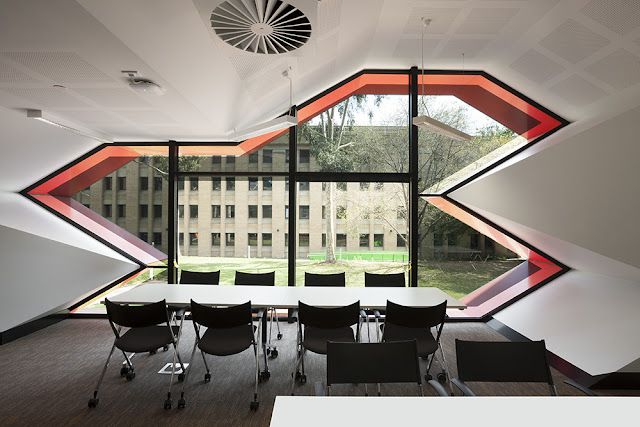La Trobe Institute for Molecular Science
Melbourne, Australia
Lyons, Australia
Year: 2013
Photos: Dianna Snape, Michael Evans, and Nils Koenning
Project's description on ArchDaily:
"The La Trobe Institute for Molecular Science (LIMS) is a major new
building on La Trobe University’s Bundoora Campus, which will meet the
University’s long-term needs in terms of student learning and research
in the science disciplines. Lyons were appointed following a design
competition sponsored by the Australian Institute of Architects. An
integral part of the brief was for the project to have a
‘transformative’ effect in terms of the architecture and identity of the
campus, which had previously been built within the strict guidelines
for materials and heights.
The building is designed around the University’s specific model for
creating a pathway for students in science; an environment where
students can develop into student researchers and ultimately into lead
researchers. The lower levels of the building accommodate first to third year
undergraduate learning spaces – with large open flexible labs
(accommodating teaching cohorts for 160 students) connected with ‘dry’
learning spaces. This allows students to move between laboratory based
project work, to digital and collaborative learning activities within
the adjacent spaces. At ground level, these learning spaces breakout to
new landscaped spaces, extending the idea of placing students at the
centre of outside social and learning areas.
The upper three levels of the building are research focused and based
around a highly collaborative model. All laboratories are large open
flexible spaces where teams are able to work together, or expand and
contract according to research funds. These large ‘super labs’ are
located immediately adjacent to write-up spaces, allowing a very direct
physical and visual connection between all research work areas.
A series of further shared spaces, including a major conference room,
staff ‘college’ lounge and informal meeting spaces, are also located on
the research levels. The design is fully integrated with the adjacent
existing building, which accommodates a number of other LIMS research
staff and laboratories. The project design also responds to the unique attributes of the
University’s Bundoora Campus, with its elevated ‘concourse’ at the first
level. The primary reception to the building is, in fact, located at
this concourse level at a ‘cross roads’ of the campus circulation in a
north/south direction.
A major stairway rises through the centre of the building, connecting
the student and research levels – as a form of representation of the
‘pathway’. The cellular exterior of the building is derived from ideas
about expressing the molecular research that is being undertaken within
the building, and is adjusted via the materiality of the building
itself. The walls are primarily precast concrete, with the cells
providing a ‘lower’ and ‘upper’ window into the various spaces, aiding
the penetration of daylight. The cellular concept also creates a
framework for a number of distinctive spaces for students to occupy or
for research staff to meet and collaborate."























No comments:
Post a Comment
Note: only a member of this blog may post a comment.